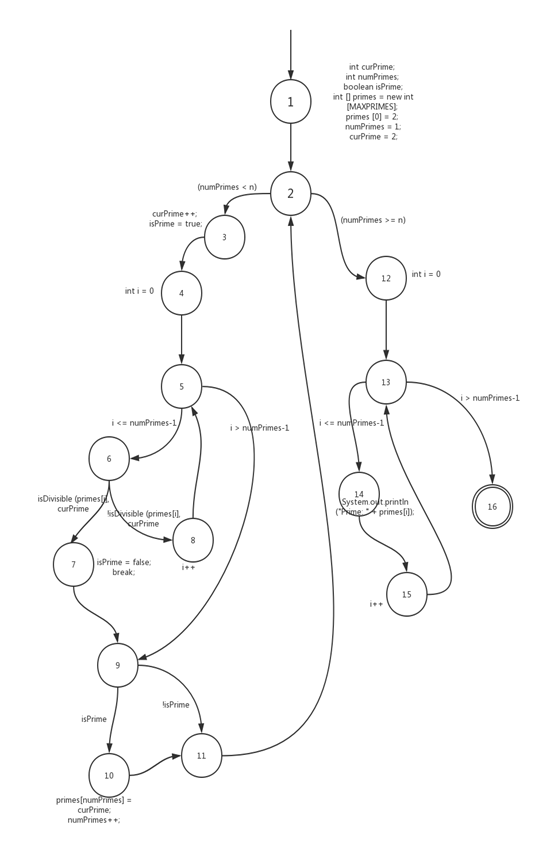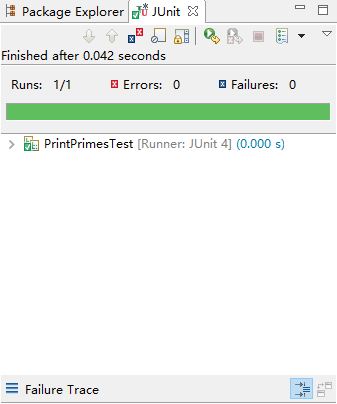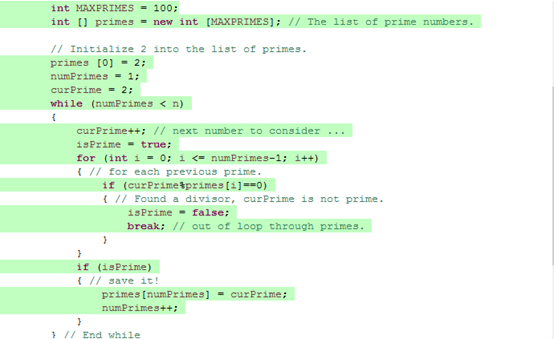软件测试之图覆盖(作业3)
上周我们学习了Junti和图覆盖的一些基础知识,为了便于更深入了解,让我们一起来实战一下吧。
一.代码及问题
/** * Finds and prints n prime integers * Jeff Offutt, Spring 2003 */ private static void printPrimes(int n) { int curPrime; //Value currently considered for primeness int numPrimes; // Number of primes found so far; boolean isPrime; //Is curPrime prime? int[] primes = new int[MAXPRIMES];// The list of primes. // Initialize 2 into the list of primes. primes[0] = 2; numPrimes = 1; curPrime = 2; while(numPrimes < n) { curPrime++; // next number to consider... isPrime = true; for(int i = 0; i <= numPrimes; i++ ) { //for each previous prime. if(isDvisible(primes[i],curPrime)) { //Found a divisor, curPrime is not prime. isPrime = false; break; } } if(isPrime) { // save it! primes[numPrimes] = curPrime; numPrimes++; } }// End while // print all the primes out for(int i = 0; i < numPrimes; i++) { System.out.println("Prime: " + primes[i] ); } }// End printPrimes.
问题如下:
(a) Draw the control flow graph for the printPrime() method. (b) Consider test cases ti = (n = 3) and t2 = ( n = 5). Although these tour the same prime paths in printPrime(), they don't necessarily find the same faults. Design a simple fault that t2 would be more likely to discover than t1 would. (c) For printPrime(), find a test case such that the corresponding test path visits the edge that connects the beginning of the while statement to the for statement without going through the body of the while loop. (d) Enumerate the test requirements for node coverage, edge coverage,and prime path coverage for the path for printPrimes().
(a) Draw the control flow graph for the printPrimes() method:

(b) Considertestcasest1=(n=3)andt2=(n=5).Although these tourthe same prime paths in printPrimes(), they do not necessarily find the same faults.Designasimplefaultthat t2 would bemorelikelytodiscover than t1 would:
将MAXPRIMES设置为4时,t2会发生数组越界错误,但t1不会发生错误。
(c) For printPrimes(), find a test case such that the corresponding test path visits the edge that connects the beginning of the while statement to the for statement without going through the body of the while loop:
当n=1时,会通过numPrimes>=直接从上图的2节点跳转到12节点,不经过while循环体内部。
(d) Enumerate the test requirements for node coverage, edge coverage, and prime path coverage for the graph for printPrimes():
点覆盖:{1,2,3,4,5,6,7,8,9,10,11,12,13,14,15,16}
边覆盖:{(1,2),(2,3),(3,4),(4,5),(5,6),(6,8),(8,5),(6,7),(7,9),(5,9),(9,10),(9,11),(10,11),(11,2),(2,12),(12,13),(13,14),(14,15),(15,13),(13,16)}
主路径覆盖:{(1,2,3,4,5,6,8),(1,2,3,4,5,6,7,9,10,11),(1,2,3,4,5,6,7,9,11),(1,2,3,4,5,9,11),(1,2,3,4,5,9,10,11),(5,6,8,5),(6,8,5,6),(8,5,6,8),(8,5,6,7,9,11),(8,5,6,7,9,10,11),(1,2,12,13,16),(1,2,12,13,14,15),(13,14,15,13),(14,15,13,14),(15,13,14,15),(14,15,13,16),(15,13,16)}
二.基于Junit及Eclemma(jacoco)实现一个主路径覆盖的测试
测试代码:
1 import static org.junit.Assert.*; 2 3 import org.junit.Before; 4 import org.junit.Test; 5 6 public class PrintPrimesTest { 7 8 private PrintPrimes pptest; 9 10 @Before 11 public void setUp() throws Exception { 12 pptest = new PrintPrimes(); 13 } 14 15 @Test 16 public void testPrintPrimes() { 17 pptest.printPrimes(5); 18 19 } 20 }
测试结果:

使用EclEmma 进行覆盖测试:




